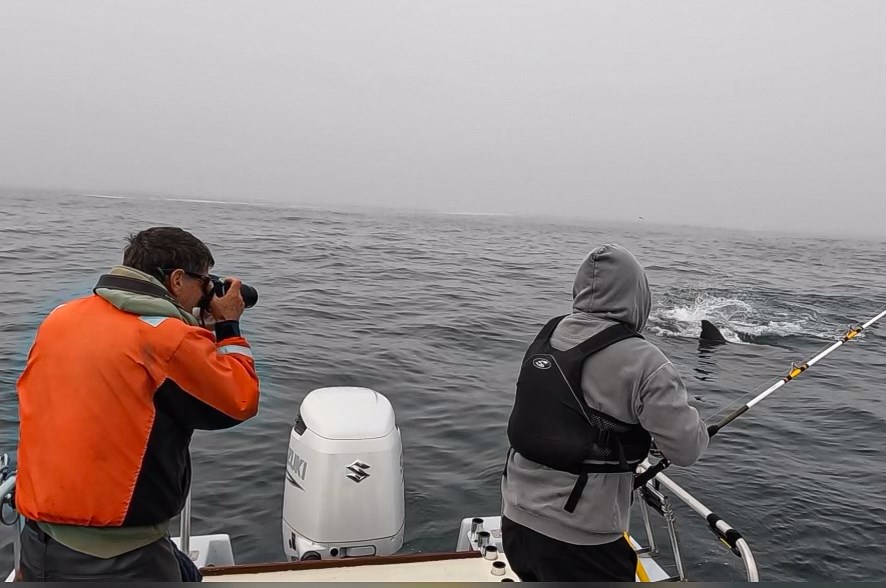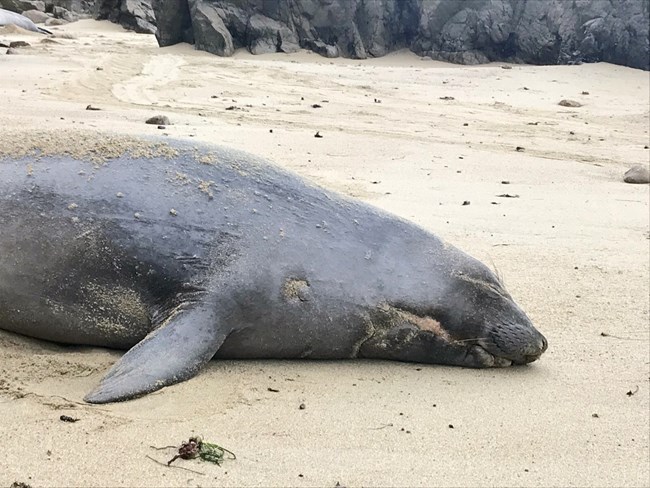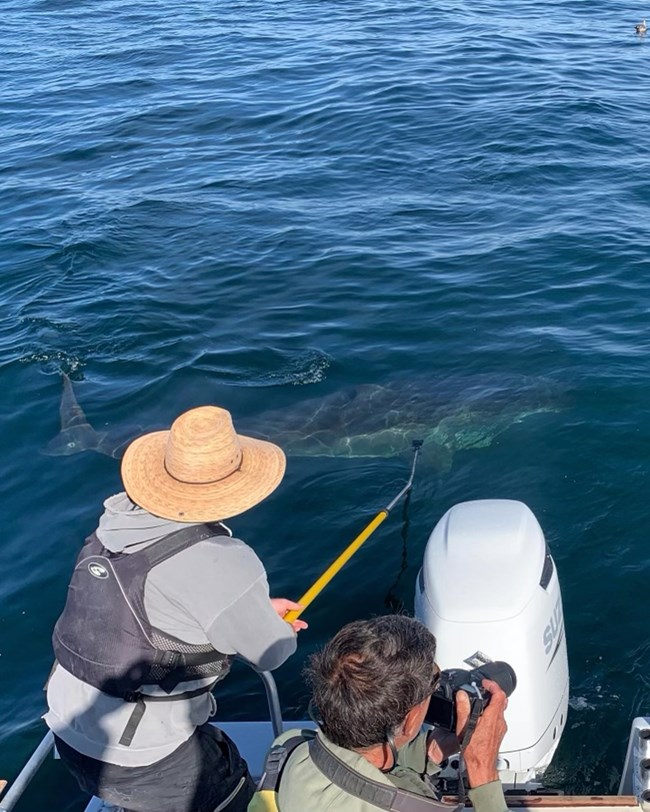Last updated: April 5, 2024
Article
Scientists Dive Deep into a White Shark Mystery at Tomales Point
By Science Communication Intern Avani Fachon, Point Reyes National Seashore Association

California White Shark Project
April 2024 - On a research boat off the coast of Tomales Point, Dr. Paul Kanive and Scot Anderson squint over glaring silvery-blue water, carefully scanning for ripples, fins, splashes, or anything that might indicate the presence of a white shark (Carcharodon carcharias). On this gloomy December day, the pair is eager to catch even a couple seconds of a shark’s grandeur amidst the Point’s expansive waters, and is expecting to see one particular long-time resident—the great patriarch, Mr. Burns.
Kanive and Anderson co-lead the nonprofit California White Shark Project (CWSP), which sustains the longest survey of white sharks in the world. Each fall and early winter, the team sets out to various sites along the California coast—including Point Reyes’ Tomales Point and the Greater Farallones National Marine Sanctuary—to keep track of shark abundance, health, and population status.
Kanive and Anderson co-lead the nonprofit California White Shark Project (CWSP), which sustains the longest survey of white sharks in the world. Each fall and early winter, the team sets out to various sites along the California coast—including Point Reyes’ Tomales Point and the Greater Farallones National Marine Sanctuary—to keep track of shark abundance, health, and population status.
The Art of Finding a Shark
At each study location, the team casts a seal decoy into the water in hopes of attracting a shark to their 16-foot vessel.* “The sharks like to be cryptic or hidden,” says Kanive. “They don’t advertise themselves, because their power is in their ability to stay camouflaged and below the radar of prey species. We’re trying to attract them by exploiting their curiosity to come up to investigate a decoy so we can take pictures and underwater video of them. They’re very curious animals.”

Maxine Meckfessel / California White Shark Project
Kanive and Anderson have decades of experience in making full use of these short-lived moments. “When you see them, you definitely have a heightened sense of the present time. Things kind of slow down and then you’re very focused on what you’re looking at, trying your very best to document the individual,” reflects Kanive. The pair methodically submerge waterproof Go-Pro cameras into the water, intent on capturing precious footage of the shark which can later be used to determine important metrics, such as their sex and length. Importantly, they focus on capturing a clear view of each shark’s dorsal fin. It has a distinctive shape and a key-like arrangement of notches and ridges unique to every individual shark—just like the arches, loops, and whorls of a fingerprint are unique to every human.
*The California White Shark Project team is permitted by federal and state agencies to attract white sharks to a research vessel for purposes of collecting scientific data.

California White Shark Project
A Scientific Pièce de Résistance
The CWSP has collected data on individual sharks since 1987, a treasure trove of long-term information. “I still have yet to express with enough clarity of how important and how valuable those uninterrupted data are, of records of individuals over time,” says Kanive. “We have the longest survey of white sharks in the world which is something unique and novel and very valuable…With all that effort, we have a general pulse on the health of this population of white sharks in central California.” For the first time, the researchers are able to keep track of trends such as population size, mortality rate, and comings and goings between populations—all of which are imperative to understanding and protecting this keystone species.
Such an extensive shark dataset is nothing short of a scientific pièce de résistance. Sharks are incredibly difficult to study; they naturally exist in low numbers, have a wide range in the marine environment, and expeditions require careful planning and an intimate knowledge of the species and the local study area—all of which contributes to why sharks have remained a mystery for so long.
“Everything about them, pretty much, was not known back in 1987, other than [if] a dead shark [was] caught in a net, or if one bit somebody,” says Anderson, reflecting on when he began the initiative. “They used to just be called ‘maneater sharks,’ they didn’t even have a real name.” Through their long-term research, the CWSP is eliminating the thick shroud of mystery surrounding these creatures.
“We learned through a lot of effort over a lot of time,” Kanive emphasizes.
Such an extensive shark dataset is nothing short of a scientific pièce de résistance. Sharks are incredibly difficult to study; they naturally exist in low numbers, have a wide range in the marine environment, and expeditions require careful planning and an intimate knowledge of the species and the local study area—all of which contributes to why sharks have remained a mystery for so long.
“Everything about them, pretty much, was not known back in 1987, other than [if] a dead shark [was] caught in a net, or if one bit somebody,” says Anderson, reflecting on when he began the initiative. “They used to just be called ‘maneater sharks,’ they didn’t even have a real name.” Through their long-term research, the CWSP is eliminating the thick shroud of mystery surrounding these creatures.
“We learned through a lot of effort over a lot of time,” Kanive emphasizes.

California White Shark Project
Ultimately, the CWSP's research is an attempt to understand how this big fish fits into the ocean’s intricate patterns and inner-workings. “In the marine environment sharks have been around for 450 million years, give or take. That’s such a massive amount of time to shape the ocean. Sharks are in every ocean around the world and they’ve helped shape the trophic levels within the ocean,” notes Kanive.
Indeed, sharks are critical to the functioning of ocean ecosystems, and as Kanive puts it, are important in preserving “the massive amounts of life and diversity that we hope to see continue to exist and thrive off of the California coast, within the California current.” They help to control prey populations, such as fish, crustaceans, mollusks, sea birds, seals and sea lions. In California, capping pinniped populations is critical for preserving salmon populations, such as the endangered coho salmon, from being overeaten. The marine ecosystem, each component of which has been carefully shaped and evolved in response to the sharks for hundreds of millions of years, would be thrown off balance if they were to disappear. The Project’s research is essential for informing management decisions to protect the sharks from overfishing, bycatch, habitat destruction, and the effects of climate change.
The Mystery at Tomales Point

NPS / Anela Kopshever
Tomales Point, at the northernmost tip of the Point Reyes peninsula, used to be a hotspot for great white sharks. From 2006-2019, Kanive and Anderson consistently spotted 30-45 sharks patrolling the Point’s waters and for sixteen years, they never failed to see the legendary Mr. Burns—a 17-foot male with a big bite taken out of his tail. They interacted with Mr. Burns an impressive 61 times and became familiar with his tendency to investigate the seal decoy from a vertical approach, surprising the researchers when he unexpectedly rose from the ocean’s depths to take a test bite. In 2020, 2021, and 2022, even when the number of sharks spotted at Tomales Point mysteriously plummeted, Kanive and Anderson still saw the faithful Mr. Burns with his characteristic dorsal fin and maimed tail.

California White Shark Project
Kanive and Anderson are perplexed about the abnormal number of sharks at Tomales Point. “A [decrease and] complete absence of sharks off Tomales Point…[is] very atypical and very different from other years,” says Kanive.
“It’s hard to say what that means,” explains Anderson. “There could be food nearby somewhere else….[such as] a dead whale on the bottom…You’ve [also] got a cat and mouse game going on with another predator—orcas. We know they move away when orcas come through. And then you’ve also got prey, which moves around as well.” Water quality can also influence the sharks’ behavior: “the water can be so turbid that they can’t see, and then other times it can be so clear that they can see so well that they don’t even come near our boat,” chuckles Anderson. “It’s really dynamic as to what would influence them to move or not.”
The Drakes Bay Hypothesis

NPS / PRNSA / Aiko Goldston - NMFS Permit No. 21425
Another promising hypothesis is tied to Drakes Bay, where elephant seal (Mirounga angustirostris) numbers are rising exponentially. Point Reyes biologists have found that the seals are moving away from beaches that directly face the ocean, such as at the Point Reyes Headlands, and towards protected beaches tucked inside bays, such as Drakes Beach.
“With the large increase of elephant seals along Drakes Beach and the decline along the ocean-side beaches, we have wondered if there would be an increase in white sharks near Drakes Bay,” says Sarah Codde, National Park Service marine ecologist.
“With the large increase of elephant seals along Drakes Beach and the decline along the ocean-side beaches, we have wondered if there would be an increase in white sharks near Drakes Bay,” says Sarah Codde, National Park Service marine ecologist.

NPS / Sarah Codde, NMFS Permit No. 21425
During the 2023-2024 field season, the team set out to test this hypothesis with support from the Point Reyes National Seashore Association’s Neubacher Marine Science Fund. For the first time, they surveyed sharks at Drakes Bay by boat.
The team found this location to be especially difficult to survey: “Drakes Bay is hard to get to—it’s further away from anywhere because…you need to go either from San Francisco or all the way from Inverness around Point Reyes…to get in there.” As a compromise to these onerous boat surveys, Anderson also spent time at Chimney Rock, stationed on the narrow peninsula and equipped with a pair of binoculars to conduct visual surveys of the bay.
A Launching Point
In spite of their efforts and contrary to their expectations, the team identified just one shark—a 13 foot long male. Kanive scribbled down a name for this new shark in his field notes: “Drake.”

Maxine Meckfessel / California White Shark Project
In addition to more boat surveys, the team has bigger hopes for the future: “Further down the line, we could do a tagging study. We could tag some sharks in Tomales and have a receiver in Drakes Bay,” says Anderson. This method could provide the team with a way to track the sharks’ movements, and how much time they’re spending in the waters of Drakes Bay vs. Tomales Point.
Because of the diversity of reasons behind why a shark might choose to relocate, the mystery of why populations at Tomales Point have decreased during this four-year period will likely remain unsolved, and continued research will reveal whether the trend continues into the future. With any luck, they’ll reunite with their old friend Mr. Burns, once again.
For More Information:
- Learn more about the California White Shark Project
- Learn more about California White Shark Project’s research as a 2023 Neubacher Marine Science Fund Grantee
- Read more about white sharks
- Contact National Park Service Marine Ecologist Sarah Codde
